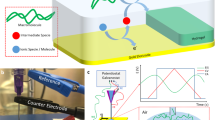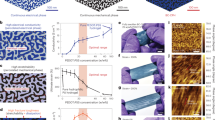Abstract
Electronics based on hydrogels can have inherent similarities to biological tissue and are of potential use in biomedical applications. Ideally, such hydrogel electronics should offer customizable three-dimensional circuits, but making complex three-dimensional circuits encapsulated within a hydrogel matrix is challenging with existing materials and manufacturing methods. Here we report the three-dimensional printing of hydrogel electronics using a curable hydrogel-based supporting matrix and a stretchable silver–hydrogel ink. The supporting matrix has a yield stress fluid behaviour, so the shear force generated by a moving printer nozzle creates a temporary fluid-like state, allowing the accurate placement in the matrix of silver–hydrogel ink circuits and electronic components. After printing, the entire matrix and embedded circuitry can be cured at 60 °C to form soft (Young’s modulus of less than 5 kPa) and stretchable (elongation of around 18) monolithic hydrogel electronics, whereas the conductive ink exhibits a high conductivity of around 1.4 × 103 S cm−1. We use our three-dimensional printing approach to create strain sensors, inductors and biological electrodes.
This is a preview of subscription content, access via your institution
Access options
Access Nature and 54 other Nature Portfolio journals
Get Nature+, our best-value online-access subscription
$29.99 / 30 days
cancel any time
Subscribe to this journal
Receive 12 digital issues and online access to articles
$119.00 per year
only $9.92 per issue
Buy this article
- Purchase on Springer Link
- Instant access to full article PDF
Prices may be subject to local taxes which are calculated during checkout






Similar content being viewed by others
Data availability
The data that support the plots within this paper and other findings of this study are available from the corresponding authors upon reasonable request.
Code availability
The code used in this paper is available from the corresponding authors on reasonable request.
References
Valentine, A. D. et al. Hybrid 3D printing of soft electronics. Adv. Mater. 29, 1703817 (2017).
Boutry, C. M. et al. Biodegradable and flexible arterial-pulse sensor for the wireless monitoring of blood flow. Nat. Biomed. Eng. 3, 47–57 (2019).
Liu, Y. et al. Morphing electronics enable neuromodulation in growing tissue. Nat. Biotechnol. 38, 1031–1036 (2020).
Yamagishi, K., Zhou, W., Ching, T., Huang, S. Y. & Hashimoto, M. Ultra-deformable and tissue-adhesive liquid metal antennas with high wireless powering efficiency. Adv. Mater. 33, 2008062 (2021).
Lu, D. et al. Bioresorbable, wireless, passive sensors as temporary implants for monitoring regional body temperature. Adv. Healthc. Mater. 9, 2000942 (2020).
Chen, Y. et al. Skin-like biosensor system via electrochemical channels for noninvasive blood glucose monitoring. Sci. Adv. 3, e1701629 (2017).
Tringides, C. M. et al. Viscoelastic surface electrode arrays to interface with viscoelastic tissues. Nat. Nanotechnol. 16, 1019–1029 (2021).
Noh, K. N. et al. Miniaturized, battery-free optofluidic systems with potential for wireless pharmacology and optogenetics. Small 14, 1702479 (2018).
Zhang, Y. et al. Battery-free, fully implantable optofluidic cuff system for wireless optogenetic and pharmacological neuromodulation of peripheral nerves. Sci. Adv. 5, eaaw5296 (2019).
Yuk, H. et al. 3D printing of conducting polymers. Nat. Commun. 11, 1604 (2020).
Choi, Y. S. et al. Stretchable, dynamic covalent polymers for soft, long-lived bioresorbable electronic stimulators designed to facilitate neuromuscular regeneration. Nat. Commun. 11, 5990 (2020).
Li, Q. et al. Cyborg organoids: implantation of nanoelectronics via organogenesis for tissue-wide electrophysiology. Nano Lett. 19, 5781–5789 (2019).
Tang, L., Shang, J. & Jiang, X. Multilayered electronic transfer tattoo that can enable the crease amplification effect. Sci. Adv. 7, eabe3778 (2021).
Lin, R., Li, Y., Mao, X., Zhou, W. & Liu, R. Hybrid 3D printing all-in-one heterogenous rigidity assemblies for soft electronics. Adv. Mater. Technol. 4, 1900614 (2019).
Kim, S. H. et al. Ultrastretchable conductor fabricated on skin-like hydrogel–elastomer hybrid substrates for skin electronics. Adv. Mater. 30, 1800109 (2018).
Yeo, W.-H. et al. Multifunctional epidermal electronics printed directly onto the skin. Adv. Mater. 25, 2773–2778 (2013).
Wang, Y. et al. A highly stretchable, transparent, and conductive polymer. Sci. Adv. 3, e1602076 (2017).
Park, J. et al. Soft, smart contact lenses with integrations of wireless circuits, glucose sensors, and displays. Sci. Adv. 4, eaap9841 (2018).
Yarali, E. et al. Magneto-/electro-responsive polymers toward manufacturing, characterization, and biomedical/ soft robotic applications. Appl. Mater. Today 26, 101306 (2022).
Yuk, H., Lu, B. & Zhao, X. Hydrogel bioelectronics. Chem. Soc. Rev. 48, 1642–1667 (2019).
Noskovicova, N. et al. Suppression of the fibrotic encapsulation of silicone implants by inhibiting the mechanical activation of pro-fibrotic TGF-β. Nat. Biomed. Eng. 5, 1437–1456 (2021).
Lin, S. et al. Stretchable hydrogel electronics and devices. Adv. Mater. 28, 4497–4505 (2016).
Liu, Y. et al. Ultrastretchable and wireless bioelectronics based on all-hydrogel microfluidics. Adv. Mater. 31, 1902783 (2019).
Liu, H. et al. Biofriendly, stretchable, and reusable hydrogel electronics as wearable force sensors. Small 14, 1801711 (2018).
Liu, H. et al. Spatially modulated stiffness on hydrogels for soft and stretchable integrated electronics. Mater. Horiz. 7, 203–213 (2020).
Xu, C., Ma, B., Yuan, S., Zhao, C. & Liu, H. High-resolution patterning of liquid metal on hydrogel for flexible, stretchable, and self-healing electronics. Adv. Electron. Mater. 6, 1900721 (2020).
Zhang, L., Gao, M., Wang, R., Deng, Z. & Gui, L. Stretchable pressure sensor with leakage-free liquid-metal electrodes. Sensors 19, 1316–1331 (2019).
Muth, J. T. et al. Embedded 3D printing of strain sensors within highly stretchable elastomers. Adv. Mater. 26, 6307–6312 (2014).
Bhattacharjee, T. et al. Writing in the granular gel medium. Sci. Adv. 1, e1500655 (2015).
Hinton, T. J. et al. Three-dimensional printing of complex biological structures by freeform reversible embedding of suspended hydrogels. Sci. Adv. 1, e1500758 (2015).
Lee, A. et al. 3D bioprinting of collagen to rebuild components of the human heart. Science 365, 482–487 (2019).
O’Bryan, C. S. et al. Self-assembled micro-organogels for 3D printing silicone structures. Sci. Adv. 3, e1602800 (2017).
Truby, R. L. et al. Soft somatosensitive actuators via embedded 3D printing. Adv. Mater. 30, 1706383 (2018).
Highley, C. B., Rodell, C. B. & Burdick, J. A. Direct 3D printing of shear-thinning hydrogels into self-healing hydrogels. Adv. Mater. 27, 5075–5079 (2015).
Luo, G. et al. Freeform, reconfigurable embedded printing of all-aqueous 3D architectures. Adv. Mater. 31, 1904631 (2019).
Sun, J.-Y. et al. Highly stretchable and tough hydrogels. Nature 489, 133–136 (2012).
Ye, Y., Zhang, Y., Chen, Y., Han, X. & Jiang, F. Cellulose nanofibrils enhanced, strong, stretchable, freezing-tolerant ionic conductive organohydrogel for multi-functional sensors. Adv. Funct. Mater. 30, 2003430 (2020).
Du, G. et al. Versatile controlled ion release for synthesis of recoverable hybrid hydrogels with high stretchability and notch-insensitivity. Chem. Commun. 51, 15534–15537 (2015).
Huang, Q., Tang, Z., Wang, D., Wu, S. & Guo, B. Engineering segregated structures in a cross-linked elastomeric network enabled by dynamic cross-link reshuffling. ACS Macro Lett. 10, 231–236 (2021).
Fassler, A. & Majidi, C. Liquid-phase metal inclusions for a conductive polymer composite. Adv. Mater. 27, 1928–1932 (2015).
Ohm, Y. et al. An electrically conductive silver–polyacrylamide–alginate hydrogel composite for soft electronics. Nat. Electron. 4, 185–192 (2021).
Pang, H., Xu, L., Yan, D.-X. & Li, Z.-M. Conductive polymer composites with segregated structures. Prog. Polym. Sci. 39, 1908–1933 (2014).
Yu, Y. et al. Multifunctional ‘hydrogel skins’ on diverse polymers with arbitrary shapes. Adv. Mater. 31, 1807101 (2019).
Acknowledgements
We thank H. Chen for assistance with the 3D printers. We also acknowledge financial support for this research by the National Natural Science Foundation of China (nos. 51905446 and 31970129). We thank C. Zhang and L. Liu from the Instrumentation and Service Center for Physical Sciences at Westlake University for technical support in data acquisition and interpretation. We also thank the Research Center for Industries of the Future (RCIF), Westlake Laboratory of Life Sciences and Biomedicine, and Westlake Education Foundation at Westlake University for supporting this work.
Author information
Authors and Affiliations
Contributions
Y.H. and N.Z. designed the research. Y.H., Y. Yao and Z.Q. fabricated the materials and devices. Y.H., Y. Yao, H.C. and Y. Yu performed the general experiments. Y.H., Q.Q. and Y. Yao conducted the electrical experiments and simulation analysis. Y. Yao, Y.H., J.L. and L.T. designed the biological experiments. Y. Yao and J.L. conducted the biological experiments. Y.H., Y. Yao and N.Z. analysed the data. Y.H., Y. Yao and N.Z. wrote and revised the manuscript.
Corresponding authors
Ethics declarations
Competing interests
The authors declare no competing interests.
Peer review
Peer review information
Nature Electronics thanks Mahdi Bodaghi and Shaoxing Qu for their contribution to the peer review of this work.
Additional information
Publisher’s note Springer Nature remains neutral with regard to jurisdictional claims in published maps and institutional affiliations.
Supplementary information
Supplementary Information
Supplementary Figs. 1–19 and and Tables 1–5.
Supplementary Video 1
EM3DP of hydrogel electronics.
Supplementary Video 2
LED lit up wirelessly by a printed hydrogel inductor.
Supplementary Video 3
A 3D inductor–LED device fabricated via the hybrid printing procedure.
Supplementary Video 4
Response of printed 3D inductor–LED device to compressive deformation.
Supplementary Video 5
Performance of printed hydrogel electronics under deformation cycles.
Supplementary Video 6
Mice hindlimb motion on sciatic nerve stimulation.
Rights and permissions
Springer Nature or its licensor (e.g. a society or other partner) holds exclusive rights to this article under a publishing agreement with the author(s) or other rightsholder(s); author self-archiving of the accepted manuscript version of this article is solely governed by the terms of such publishing agreement and applicable law.
About this article
Cite this article
Hui, Y., Yao, Y., Qian, Q. et al. Three-dimensional printing of soft hydrogel electronics. Nat Electron 5, 893–903 (2022). https://doi.org/10.1038/s41928-022-00887-8
Received:
Accepted:
Published:
Issue Date:
DOI: https://doi.org/10.1038/s41928-022-00887-8
This article is cited by
-
Ultra-sensitive, highly linear, and hysteresis-free strain sensors enabled by gradient stiffness sliding strategy
npj Flexible Electronics (2024)
-
Gradient matters via filament diameter-adjustable 3D printing
Nature Communications (2024)
-
An injectable, self-healable, and reusable PEDOT:PSS/PVA hydrogel patch electrode for epidermal electronics
Nano Research (2024)
-
Recent advances in 3D printable conductive hydrogel inks for neural engineering
Nano Convergence (2023)
-
Omnidirectional printing of stretchable electronics
Nature Electronics (2023)



